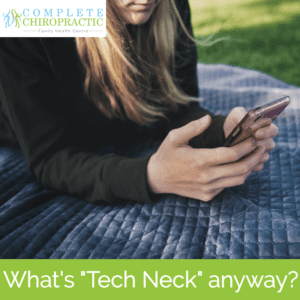Recently, we’ve been hearing a lot of hype about what’s being called “tech neck” – this isn’t surprising, since the pandemic began many of us have been forced to work or study online, but is “tech neck” a new issue, or just an old one, rebranded?
What is “Tech Neck”
Tech neck is, apparently the result of spending a great deal of time using a device. Smartphones and tablets have quickly become a part of our everyday life – and many kids already spent hours per day messaging with friends and playing the latest games… even before lockdown Often, it’s done with their neck bent forward, shoulders rounded, and arms holding the phone up in front of their eyes. Many of us working from home like to think that we’re slightly better off sitting at a desk (you probably aren’t). Tech neck, as its called, leads to pain in the neck, headaches and dizziness.
So, is this new?
If you’ve been reading the blog for a while, this may all sound familiar – it’s what chiropractors have been calling “text neck” for years. In fact, even “text neck” isn’t a new phenomenon – before phones were the cause of neck pain, books (yes, those same books you beg your children to read!) were the cause of this “head down” posture.
Can we prevent or treat “tech neck”?
For years, we campaigned to raise awareness of the problems associated with what was then being called “text neck”. It’s true that regular stretching and exercise can help to prevent the condition – but (and this is an unusual one for us!) with the way the world is today, it may just not be realistic for most people to avoid “tech neck”. Going forward, the condition is likely to become as “normal” as low back pain is today.
The good news is that even if tech neck isn’t really stoppable, chiropractic care is an ideal approach for treating the problem– in fact, children and young people seek chiropractic care more than any other non-medical intervention for neck pain[2]. Although its cause is specific in nature, text neck can be treated just like any other form of neck pain – and there’s ample research to show that chiropractic is one of the best way to do this. Obviously, prevention is preferable if possible – but regular adjustments to stay on top of the condition and stay out of pain are also a viable way forward.
Treatment for text neck typically consists of an initial consultation (which is important to rule out any other factors which may be aggravating the condition) following by the usual course of gentle chiropractic adjustments. Depending on the age of the patient, even more, gentle methods can be utilised to achieve results with less force required.[3]
Neck pain also tends to respond very quickly to chiropractic care – one 2016 study[4] looked at 60 patients being treated for neck pain and showed that overall, fairly few treatments were needed for an episode of care, especially for the young. For young people, the average frequency of visits in this study was just five, over the course of 19 days. Of these patients, 96% reported a favourable outcome. A similar frequency was reported in 2012, when another research project found that the length of treatment varied by patient age and condition treated; however, for those between 13 and 18 years, the average number of treatments was 4.6 for neck pain.[5] Treatment times for adults tend to be slightly longer, with analysis of chiropractic treatments for neck pain and headaches for adults suggesting the average number of visits for adults with neck pain, per episode of care, is 10 visits (median 6 days).[6]
Tech Neck – cause for concern?
Tech Neck is just the latest name for the neck pain associated with that classic “head down” position. While it something to stay on top of, it’s not something to panic about – try to avoid this posture where you can, but where you can’t, take advantage of a natural approach like chiropractic to avoid pain.
[1] Prominent exostosis projecting from the occipital squama more substantial and prevalent in young adult than older age groups. Scientific Reports 2018
[2] Ndetan, H, Evans, MW, Hawk, C, and Walker, C. Chiropractic or Osteopathic Manipulation for Children in the United States: An Analysis of Data from the 2007 National Health Interview Survey J Altern Complement Med. 2012 (Apr); 18 (4): 347–353
Spiggelblatt L, Liane-Ammara G, Pless B, Guyver A. The use of alternative medicine by children. Pediatrics. 1994;94:811–814.
Kemper KJ, Vohra S, Walls R. The use of complementary and alternative medicine in pediatrics. Pediatrics. 2008;122(6):1374–1386.
[3] Hawk C, Schneider M, Ferrance RJ, Hewitt E, Van Loon M. Best Practices Recommendations for Chiropractic Care for Infants, Children, and Adolescents: Results of a Consensus Process J Manipulative Physiol Ther. 2009 (Oct); 32 (8): 639–647
Marchand AM. A literature review of pediatric spinal manipulation and chiropractic manipulative therapy: evaluation of consistent use of safe terminology. J Manipulative Physiol Ther. 2012;1–7.
[4] Jocelyn Cox, et al. Neck Pain In Children: A Retrospective Case Series J Can Chiropr Assoc. 2016 (Sep); 60 (3): 212–219
[5] Marchand AM. A literature review of pediatric spinal manipulation and chiropractic manipulative therapy: evaluation of consistent use of safe terminology. J Manipulative Physiol Ther. 2012;1–7.
[6] Hurwitz EL, Coulter ID, Adams AH, et al. Use of chiropractic services from 1985 through 1991 in the United States and Canada. Am J Public Health. 1998; 88:771–776.

